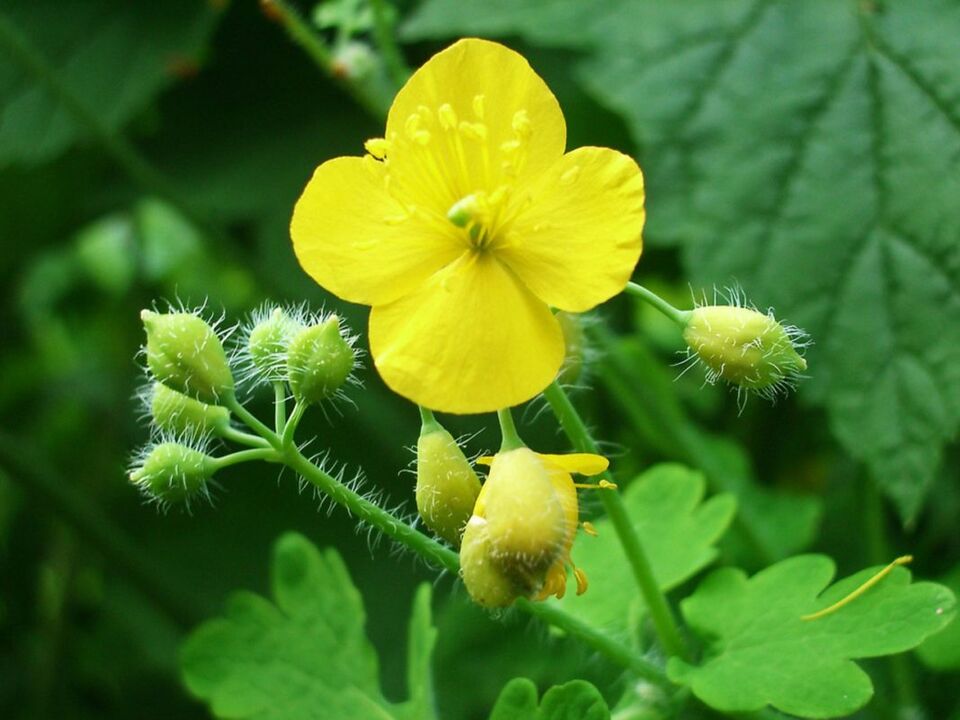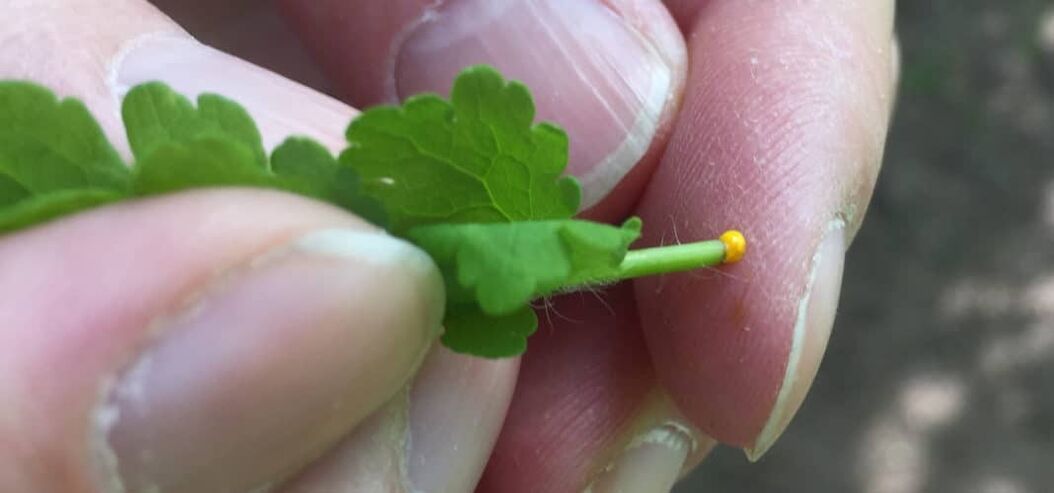Celandine is used in folk medicine mainly because of its yellow milk juice. In Europe, Asia and North America, the plant is located near settlements. With the introduction of synthetic drugs, celandine is increasingly forgotten, which is why it is often called a weed. Previously, medicinal plants were prescribed to combat warts and skin diseases. Clinical efficacy has been demonstrated in two controlled studies. Celandine from papillomas is applied in the form of an ointment or gel to problem areas of the skin.
Composition and useful properties of celandine for papillomavirus
Celandine contains about 20 isoquinoline alkaloids, found mainly in milk juice. The concentration of alkaloids in grass is from 0. 48 to 1. 04%, in the roots - up to 1. 95%.
Other chemical compounds in celandine from papilloma:
- organic acids (kelidonic, malic, citric, ferulic acid);
- phenolic acid derivatives;
- saponins, large amounts of calcium salts and proteolytic enzymes;
- flavonoid;
- biogenic amines (including histamine, tyramine);
- detect the amount of essential oils;
- carotene;
- vitamin C.
Glycogen is a storage substance in celandine. The seeds contain 40-60% vegetable oil. The plant stinks and has a bitter taste. Strong odors can cause sneezing, coughing, and even vomiting in sensitive people.
Initially, celandine was found in temperate and warm regions of Europe and Asia, as well as in the Mediterranean, including North Africa. It was brought to North America by settlers who used it as a remedy for skin diseases. Celandine is a common weed plant, i. e. it grows on rubble, debris, courtyard squares, edges and on fences, walls, fences, fields and meadows.
Celandine derives its stem from a thick rhizome, i. e. an orange in it (like milk juice). The flowers consist of two sepals, four golden yellow, ovate petals and numerous stamens. A 3-4 cm long capsule is formed from the ovary. Black seed has an oily attachment that is eaten by ants. They also distribute it in the area.
Celandine is used to treat cramps in the bile ducts and gastrointestinal tract. Whether celandine can treat warts, as traditional medicine claims, is ultimately not proven. The stems, leaves and flowers of celandine contain up to 1% alkaloids - chelidonine, coptisine and sanguinarine.
According to studies, medicinal plants have anticonvulsant and choleretic effects. Therefore, its use in spasmodic disorders in the bile ducts and gastrointestinal tract is medically proven.
Celandine also has mild analgesic, inhibits cell division, and antiviral effects. The last two effects may explain the long -term use of celandine against warts (caused by the virus).
In medicine, celandine is used, collected during flowering (only the upper part of the plant soil). It is recommended to use only ready -made preparations with a standard alkaloid content. The reason is that the part of the plant itself contains an unclear amount of alkaloids. Excessive plant material is harmful to the liver.
Almost all parts of celandine contain alkaloids. The stems contain from 0. 1 to 1% alkaloids, depending on their origin and drying conditions. More than 30 different benzylisoquinoline derivatives (such as benzophenatridine, protoberberine, and protopine) have been identified in laboratory studies. Copticine is a major alkaloid, accounting for up to 90%. Chelidonine is the major alkaloid in the roots. Other alkaloids in herbs and roots are berberine, chelerythrine, sparteine, helidoxanthin, and sanguinarine. In the fall, the chemicals are concentrated in the roots, which then become very toxic.
Various plant acids - chelidonic acid, citric acid, malic acid and caffeic acid - are found in small amounts. Celandine is not rich in flavonoids. The orange-yellow color of milk juice is due to carotenoids and some alkaloids such as berberine.

Celandine has an antispasmodic effect on the upper digestive tract and stimulates bile flow. The antispasmodic effect is now considered to be proven. It is possible to prove the choleretic effect only a few years ago. In addition, antimicrobial, antiviral, and antitumor effects have been demonstrated for the extract.
Methods of application in the treatment of pathology
Celandine refers to folk remedies, so it is recommended to weigh the benefits and risks before use. A statement was issued advising not to take celandine preparations because of its adverse effects on the liver.
Traditionally, fresh milk juice is used to treat warts, corneas and calluses. Protein (proteolytic) and antiviral mechanisms are discussed as major healing actions. Currently, alkaloid extracts are widely used as standard medicine.
The main use of celandine is the treatment of skin diseases such as warts or calluses. For cramps in the upper digestive tract, the herb was previously used as a tea or tincture.
Internal use of celandine is no longer recommended. Since the whole plant contains a high proportion of toxic alkaloids, especially in the roots, it causes poisoning. On the other hand, the toxic effects of the substance are reduced in dried herbs. It must be said that the content of toxic components varies depending on the place, plant and season. Everyone has a different constitution and therefore differs in sensitivity to toxins. If the plant is used externally, in some cases it can irritate the skin or cause allergies.
Pharmaceutical preparations based on celandine from papilloma
Finished products containing celandine are available in the form of capsules, dragees, tablets and drops. It is recommended to use celandine papilloma according to the instructions in the appropriate packaging or as recommended by a doctor. Traditionally, the milk juice of medicinal plants or celandine tincture is used on warts to get rid of them. How to actually use medication from papilloma, the doctor will tell you.
Since the end of the 20th century, there have been reports of acute liver damage in patients treated with celandine preparations. Laboratory tests confirmed the high sensitivity of human hepatocytes to the alkaloids contained in celandine. As a result, supplies of celandine are now withdrawn from pharmacies. According to the European Medical Agency 2010, the benefits of using drugs do not offset the risks to the health of patients.
Folk recipes based on celandine for HPV
Not everyone knows how to use celandine properly. Due to its toxic nature, treatment with the plant can only be carried out under the supervision of a physician. The maximum daily dose is 12-30 mg of alkaloids, which is 2-5 g of hay. When treating warts, it is recommended to treat warts with milk juice several times a day, trying not to cause blisters on healthy skin. Care should be taken that this juice does not get into the eyes, as it causes a strong burning sensation. Wraps with milk juice are useful in the treatment of skin mycoses and wounds that are difficult to heal.
Decoctions, infusions and capsules
With menstrual problems, human papillomavirus and stomach cramps, tea or celandine capsules can help. In this case, antispasmodic properties are indicated. However, internal use is not recommended as the ingredients may be toxic. At excessive doses and long -term use increases the risk of gastrointestinal disorders.
Diluted tea and diluted tincture can be used externally for skin diseases - eczema, warts or acne. It is recommended to pour 200 ml of boiling water over one teaspoon and let it brew for 10 minutes. Then moisten the cloth with tea and apply to the affected area in the form of compresses.
Oil and milk solution
For the treatment of warts and corns, celandine milk is used because of its anti-inflammatory alkaloids. It is recommended to cut a few stalks of celandine and apply the yellow juice that flows directly to the affected area 2-3 times a day for several weeks. The juice can only be used on diseased tissues because of its irritating effect.

You can also make a tincture of herbs or flowering roots and use it as a milk juice. Colored celandine can be found in health food stores. Since the tincture is not as strong as the juice, the duration of use increases.
Side effects and contraindications
Rarely, gastrointestinal complaints occur. Some patients have experienced deterioration of liver function and jaundice with prolonged use of celandine. This may be due to an excess of alkaloids or abuse (e. g. , severe inflammation of the liver or bile ducts). Overdose of celandine can also cause stomach pain, intestinal colic, and blood in the urine.
The isoquinoline alkaloids are responsible for the toxic effects. Symptoms of poisoning include pain and burning in the mouth, salivation, diarrhea, and coughing up blood. In severe cases, dizziness, impaired consciousness (including deep coma), decreased blood pressure, and tachycardia occur. Cases of fatal intoxication (in children) have been reported. Celandine juice can also cause skin irritation (burning, swelling, ulcers) and conjunctivitis (burning, watery eyes). Animal poisoning usually does not occur because they avoid celandine because of its unpleasant smell and taste.
It should follow the dosage and duration of use indicated in the leaflet or obtained from a doctor. Without interruption, celandine should be used for a maximum of four weeks.
Celandine should not be used in pre -existing or past liver disease, gallstones, inflammation of the bile ducts, blocked bile ducts, or liver damage. In addition, pregnant women, lactating women and children under the age of 12 should refrain from using celandine.
If signs of liver damage appear during treatment (e. g. , yellowing of the skin or eyes, dark urine, pain in the upper abdomen, nausea, loss of appetite), treatment should be stopped immediately and see a doctor.
Preparations with celandine should not be used for peptic ulcer, glaucoma and acute catarrh of the gastrointestinal tract. With prolonged use of the alkaloid celandine, there is a risk of developing glaucoma.























